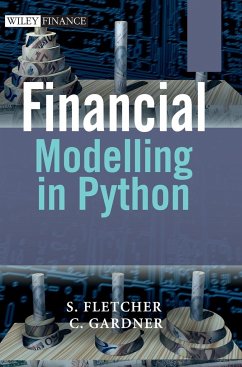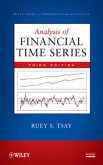This book will: Show the reader how to get started quickly: Although the Python programming language is a powerful object-oriented language, it's easy to learn, especially for programmers already familiar with C or C++. Show the reader how to write less code: Comparisons of program metrics (class counts, method counts, and so on) suggest that a program written in the Python programming language can be four times smaller than the same program written in C++. Show the reader how to write better code: The Python programming language encourages good coding practices, and automatic garbage collection helps you avoid memory leaks. Show the reader how to develop programs more quickly: The Python programming language is simpler than C++, and as such, your development time could be up to twice as fast when writing in it. Your programs will also require fewer lines of code. Chapter by chapter this book gradually builds up a practical body of code that will serve as an extensible financial engineering system in python. The book uses the Black-Scholes example to begin the building of the python package that will house the code that will be presented as the book progresses. Contents 1 Welcome to Python 1.1 Why Python? 1.1.1 Python is a high-level programming language 1.1.2 Python 'plays well with others' 1.1.3 Common misconceptions about Python 1.2 Roadmap for this book 2 First steps with Python 2.1 The Black-Scholes Formula 2.2 Modules and Packages 2.3 Unit-testing 3 Extending Python from C++ 3.1 Boost.Datetime types 3.2 Boost.MultiArray types 4 Basic Mathematical Tools 4.1 Random number generation 4.2 N(.) 4.3 Interpolation 4.3.1 Interpolation in a single dimension 4.3.2 Interpolation in multiple-dimensions 4.4 Root-finding 4.4.1 Bisection Method 4.4.2 Newton-Raphson Method 4.5 Quadrature 4.5.1 Hermite 4.5.2 Piecewise constant polynomial integration 4.6 Linear Algebra 4.6.1 Matrix Inversion 4.6.2 Singular Value Decomposition 4.6.3 Solving Tridiagonal Systems 4.6.4 Solving linear systems 4.6.5 Pseudo square root 5 Curve and surface construction 5.1 Discount Factor Curves 5.2 Caplet Volatility Curves 5.3 Intensity Curves 5.4 Swaption Volatility Skew Cube 6 Pricing using Numerical Methods 6.1 Monte-Carlo pricing framework 6.2 A lattice pricing framework 7 The Hull-White model 7.1 A component based design 7.1.1 The state 7.1.2 The cache 7.1.3 The requestor 7.1.4 The filler 7.1.5 The rollback 7.1.6 The evolve 7.2 Pricing a Bermudan 7.3 Pricing a TARN 8 Hybrid Python/C++ Pricing Systems Appendices 1 A Survey of Python Programming Tools .2 Hull-White model
"Fletcher and Gardner have created a comprehensive resource that will be of interest not only to those working in the field of finance, but also to those using numerical methods in other fields such as engineering, physics, and actuarial mathematics. By showing how to combine the high-level elegance, accessibility, and flexibility of Python, with the low-level computational efficiency of C++, in the context of interesting financial modeling problems, they have provided an implementation template which will be useful to others seeking to jointly optimize the use of computational and human resources. They document all the necessary technical details required in order to make external numerical libraries available from within Python, and they contribute a useful library of their own, which will significantly reduce the start-up costs involved in building financial models. This book is a must read for all those with a need to apply numerical methods in the valuation of financial claims."
- David Louton, Professor of Finance, Bryant University
This book is directed at both industry practitioners and students interested in designing a pricing and risk management framework for financial derivatives using the Python programming language.
It is a practical book complete with working, tested code that guides the reader through the process of building a flexible, extensible pricing framework in Python. The pricing frameworks loosely coupled fundamental components have been designed to facilitate the quick development of new models. Concrete applications to real-world pricing problems are also provided.
Topics are introduced gradually, each building on the last. They include basic mathematical algorithms, common algorithms from numerical analysis, trade, market and event data model representations, lattice and simulation based pricing, and model development. The mathematics presented is kept simple and to the point.
The book also provides a host of information on practical technical topics such as C++/Python hybrid development (embedding and extending) and techniques for integrating Python based programs with Microsoft Excel.
"Fletcher and Gardner have created a comprehensive resource that will be of interest not only to those working in the field of finance, but also to those using numerical methods in other fields such as engineering, physics, and actuarial mathematics. By showing how to combine the high-level elegance, accessibility, and flexibility of Python, with the low-level computational efficiency of C++, in the context of interesting financial modeling problems, they have provided an implementation template which will be useful to others seeking to jointly optimize the use of computational and human resources. They document all the necessary technical details required in order to make external numerical libraries available from within Python, and they contribute a useful library of their own, which will significantly reduce the start-up costs involved in building financial models. This book is a must read for all those with a need to apply numerical methods in the valuation of financial claims."
- David Louton, Professor of Finance, Bryant University
This book is directed at both industry practitioners and students interested in designing a pricing and risk management framework for financial derivatives using the Python programming language.
It is a practical book complete with working, tested code that guides the reader through the process of building a flexible, extensible pricing framework in Python. The pricing frameworks loosely coupled fundamental components have been designed to facilitate the quick development of new models. Concrete applications to real-world pricing problems are also provided.
Topics are introduced gradually, each building on the last. They include basic mathematical algorithms, common algorithms from numerical analysis, trade, market and event data model representations, lattice and simulation based pricing, and model development. The mathematics presented is kept simple and to the point.
The book also provides a host of information on practical technical topics such as C++/Python hybrid development (embedding and extending) and techniques for integrating Python based programs with Microsoft Excel.








